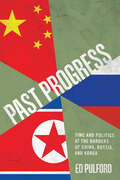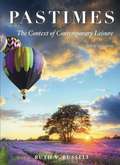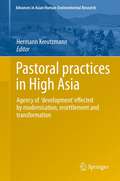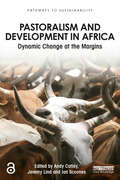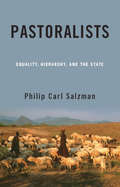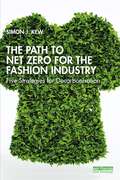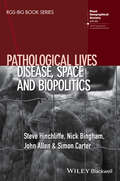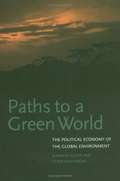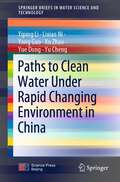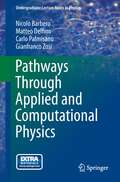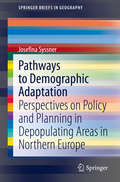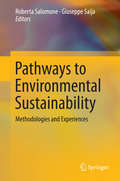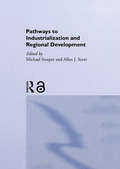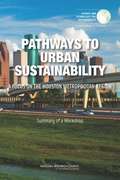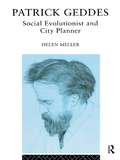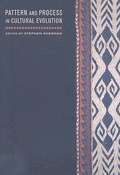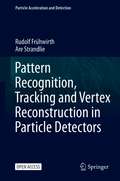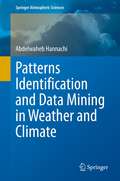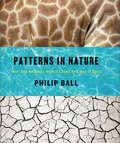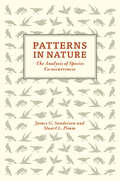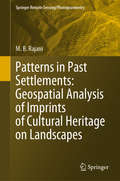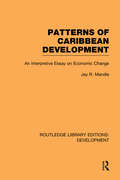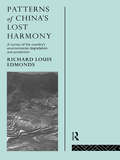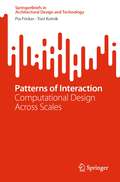- Table View
- List View
Past Progress: Time and Politics at the Borders of China, Russia, and Korea
by Ed PulfordWhile anxiety abounds in the old Cold War West that progress – whether political or economic – has been reversed, for citizens of former-socialist countries, murky temporal trajectories are nothing new. Grounded in the multiethnic frontier town of Hunchun at the triple border of China, Russia, and North Korea, Ed Pulford traces how several of global history's most ambitiously totalizing progressive endeavors have ended in cataclysmic collapse here. From the Japanese empire which banished Qing, Tsarist, and Choson dynastic histories from the region, through Chinese, Soviet, and Korean socialisms, these borderlands have seen projections and disintegrations of forward-oriented ideas accumulate on a grand scale. Taking an archaeological approach to notions of historical progress, the book's three parts follow an innovative structure moving backwards through linear time. Part I explores "post-historical" Hunchun's diverse sociopolitics since high socialism's demise. Part II covers the socialist era, discussing cross-border temporal synchrony between China, Russia, and North Korea. Finally, Part III treats the period preceding socialist revolutions, revealing how the collapse of Qing, Tsarist, and Choson dynasties marked a compound "end of history" which opened the area to projections of modernity and progress. Examining a borderland across linguistic, cultural, and historical lenses, Past Progress is a simultaneously local and transregional analysis of time, borders, and the state before, during, and since socialism.
Pastimes: The Context of Contemporary Leisure (Fifth Edition)
by Ruth V. RussellOriginally published in 1996, "Pastimes" introduced an exciting new text that explored leisure and recreation philosophy and science, the various subfields, and the leisure services industry. The purpose of this fifth edition of Pastimes is to extend the discussion about leisure in society to new concepts supported by new research findings and commentary. Throughout, the author has pursued the most interesting, relevant, exciting, and contemporary information possible. First, as an introduction to the phenomenon of leisure, the book must be current. Momentous changes, actual and alleged, have always been the root of leisure expressions and experiences. To match, Pastimes again reflects a wide range of material from the disciplines of leisure studies, sociology, psychology, economics, political science, anthropology, geography, the humanities, and media and cultural studies. Second, as a learning tool, this fifth edition teaches more. It contains new illustrations of concepts through field-based cases, biographical features, exploratory activities, and research studies. While the basic organisation remains similar, in addition to new material, some former concepts have been relocated. For example, the topic of history and its meanings for leisure is now combined into one chapter. Also, the discussion of work is now combined with that about economics in the same chapter. Also, theories explaining leisure behaviour are now organised according to their home discipline. A chapter on well-being and leisure is a new feature, and because of the amazing speed of change, the chapter on leisure and technology has been completely rewritten. The chapter on time has also been expanded. Finally, the last chapter on leisure systems has a new section on professional preparation. But, more than a textbook, Pastimes is very much a point of view. Leisure is presented as a human phenomenon that is individual and collective, vital and frivolous, historical and contemporary, factual and subjective, good and bad.
Pastoral practices in High Asia
by Hermann KreutzmannIn conventional views, pastoralism was classified as a stage of civilization that needed to be abolished and transcended in order to reach a higher level of development. In this context, global approaches to modernize a rural society have been ubiquitous phenomena independent of ideological contexts. The 20th century experienced a variety of concepts to settle mobile groups and to transfer their lifestyles to modern perceptions. Permanent settlements are the vivid expression of an ideology-driven approach. Modernization theory captured all walks of life and tried to optimize breeding techniques, pasture utilization, transport and processing concepts. New insights into other aspects of pastoralism such as its role as an adaptive strategy to use marginal resources in remote locations with difficult access could only be understood as a critique of capitalist and communist concepts of modernization. In recent years a renaissance of modernization theory-led development activities can be observed. Higher inputs from external funding, fencing of pastures and settlement of pastoralists in new townships are the vivid expression of 'modern' pastoralism in urban contexts. The new modernization programme incorporates resettlement and transformation of lifestyles as to be justified by environmental pressure in order to reduce degradation in the age of climate change.
Pastoralism and Development in Africa: Dynamic Change at the Margins (Pathways to Sustainability)
by Author UnknownOnce again, the Horn of Africa has been in the headlines. And once again the news has been bad: drought, famine, conflict, hunger, suffering and death. The finger of blame has been pointed in numerous directions: to the changing climate, to environmental degradation, to overpopulation, to geopolitics and conflict, to aid agency failures, and more. But it is not all disaster and catastrophe. Many successful development efforts at ‘the margins’ often remain hidden, informal, sometimes illegal; and rarely in line with standard development prescriptions. If we shift our gaze from the capital cities to the regional centres and their hinterlands, then a very different perspective emerges. These are the places where pastoralists live. They have for centuries struggled with drought, conflict and famine. They are resourceful, entrepreneurial and innovative peoples. Yet they have been ignored and marginalised by the states that control their territory and the development agencies who are supposed to help them. This book argues that, while we should not ignore the profound difficulties of creating secure livelihoods in the Greater Horn of Africa, there is much to be learned from development successes, large and small. This book will be of great interest to students and scholars with an interest in development studies and human geography, with a particular emphasis on Africa. It will also appeal to development policy-makers and practitioners.
Pastoralists: Equality, Hierarchy, and the State
by Philip Carl SalzmanDrawing upon the author's extensive field research among pastoral peoples in the Middle East, India, and the Mediterranean, and on more than 30 years of comparative study of pastoralists around the world, Pastoralists is an authoritative synthesis of the varieties of pastoral life. At an ethnographic level, the concise volume provides detailed analyses of divergent types of pastoral societies, including segmentary tribes, tribal chiefdoms, and peasant pastoralists. At the same time, it addresses a set of substantive theoretical issues: ecological and cultural variation, equality and inequality, hierarchy and the basis of power, and state power and resistance. The book validates "pastoralists" as a conceptual category even as it reveals the diversity of societies, subsistence strategies, and power arrangements subsumed by that term.
The Path to Net Zero for the Fashion Industry: Five Strategies for Decarbonisation
by Simon J. KewThis book uses a quantitative science-based approach to explain where the greenhouse gas (GHG) emissions emitted by the fashion industry are generated and it explores what strategies can be deployed to achieve Net Zero by 2050. With GHG emissions currently predicted to triple by the middle of the century, the fashion industry is far off course to reach Net Zero, as set out in the Paris Agreement. With misinformation and greenwashing representing an ever-growing barrier to potential solutions, the book aims to demystify the source of GHG emissions from the industry, breaking down in detail their origin, while identifying the steps that can be taken when designing and sourcing new products. Detailing the market drivers and trends in fashion consumption, it argues that change should be guided by science-based quantitative principles. Accessibly written with key insights at the end of each chapter, this book will enable the reader to understand the tactics to tackle decarbonisation, and ultimately outline five main strategies that can be deployed by the fashion and textile industries to align with the Paris Agreement. This book serves as a practical guide for designers, buyers and the fashion industry in general to develop and understand approaches and strategies to reduce energy consumption and the resulting GHG emissions to reach Net Zero.
Pathological Lives: Disease, Space and Biopolitics
by John Allen Nick Bingham Simon Carter Steve HinchliffePandemics, epidemics and food borne diseases are a major global challenge. Focusing on the food and farming sector, and mobilising social theory as well as empirical enquiry, Pathological Lives investigates current approaches to biosecurity and ask how pathological lives can be successfully ‘regulated’ without making life more dangerous as a result. Uses empirical and social theoretical resources developed in the course of a 40-month research project entitled ‘Biosecurity borderlands’ Focuses on the food and farming sector, where the generation and subsequent transmission of disease has the ability to reach pandemic proportions Demonstrates the importance of a geographical and spatial analysis, drawing together social, material and biological approaches, as well as national and international examples The book makes three main conceptual contributions, reconceptualising disease as situated matters, the spatial or topological analysis of situations and a reformulation of biopolitics Uniquely brings together conceptual development with empirically and politically informed work on infectious and zoonotic disease, to produce a timely and important contribution to both social science and to policy debate
Paths to a Green World: The Political Economy of the Global Environment
by Jennifer Clapp Peter DauvergneThis comprehensive and accessible text fills the need for a political economy view of global environmental politics, focusing on the ways key economic processes affect environmental outcomes.
Paths to Clean Water Under Rapid Changing Environment in China (SpringerBriefs in Water Science and Technology)
by Yiping Li Lixiao Ni Yong Guo Xu Zhao Yue Dong Yu ChengThis book mainly provides the current status of water pollution faced by China under rapid changing environment and the actions that have been taken for prevention and treatment of water pollution. It points out that the water pollution situation is severe. Facing water pollution, China’s experiences include several aspects on source control and pollution interception, internal nutrient removal of sediment, ecological restoration, and water transfer policy. There exists both the opportunity and challenge for the prevention and control of water pollution in China. The book contains numerous charts and diagrams which further illustrating China’s paths to clean water.
Pathways Through Applied and Computational Physics
by Nicolò Barbero Matteo Delfino Carlo Palmisano Gianfranco ZosiThis book is intended for undergraduates and young researchers who wish to understand the role that different branches of physics and mathematics play in the execution of actual experiments. The unique feature of the book is that all the subjects addressed are strictly interconnected within the context of the execution of a single experiment with very high accuracy, namely the redetermination of the Avogadro constant NA, one of the fundamental physical constants. The authors illustrate how the basic laws of physics are applied to describe the behavior of the quantities involved in the measurement of NA and explain the mathematical reasoning and computational tools that have been exploited. It is emphasized that all these quantities, although pertaining to a specific experiment, are of wide and general interest. The book is organized into chapters covering the interaction of electromagnetic radiation with single crystals, linear elasticity and anisotropy, propagation of thermal energy, anti-vibration mounting systems, and data analysis and B-spline interpolation. An essential feature is the focus on the role of Mathematica, an invaluable, fully integrated software environment for handling diverse scientific and technical computations.
Pathways to Demographic Adaptation: Perspectives on Policy and Planning in Depopulating Areas in Northern Europe (SpringerBriefs in Geography)
by Josefina SyssnerThis book builds on case studies in depopulating and shrinking areas in Northern Europe. While most contemporary literature on shrinkage focuses on these issues from a planning standpoint, this book uniquely applies a policy perspective when approaching the material. The book assesses the potential of demographic adaptation policies to manage depopulation, that is, policy programs aiming at managing depopulation through adaptation, rather than through growth policies intended to foster population growth. In 6 chapters, the book acts as an up-to-date resource on demographic adaptation for master and Ph.D. students, researchers, and practitioners working in local and regional development, governance, and planning. Chapter 1 gives an overview of recent demographic trends in Northern Europe and introduces the theoretical differences between growth policy and adaptation policy. Chapter 2 accounts for the policy concept and introduces a framework for how local adaptation policies could be systematically analysed. Chapter 3 suggests that the Nordic welfare states exhibit two characteristics that prove to be relevant when discussing the consequences and policy implications of demographic decline, i.e. an extremely sparse population structure and an ambitious welfare assignment that in many respects has been devolved to the local level of government. Chapter 4 suggests that whether shrinkage constitutes a problem or not depends upon the interpretations of those in power, but also upon political, economic and geographic conditions Chapter 5 seeks to understand why local level policymakers avoid developing strategies for how to handle long-term population decline. Chapter 6 summarizes the points of the previous chapters, and concludes that local governments in shrinking areas ought to develop local adaptation policies. These policies, however, also need to be subjected to critical analysis, and the chapter introduces a model for how local adaptation policy priorities could be assessed in a more structured manner.
Pathways to Environmental Sustainability
by Roberta Salomone Giuseppe SaijaThis book brings together, in a single volume, an overview of multiple applications of the concept of environmental sustainability, featuring examples of useful methodologies and tools for pursuing environmental targets, experiences and case studies spanning a variety of sectors, embracing both industry and research projects; and case studies applied to very different territorial contexts. The first section of the book covers methodologies and tools for environmental sustainability, including Industrial Ecology, Urban Metabolism, Life Cycle Assessment, analysis of industrial water footprint and such chemical technologies as Hypercritical Separation Technology (HYST). Part Two provides case studies of environmental sustainability in specific industrial sectors including electronics, pharmaceutical manufacturing, bio-energy, agriculture, food and residential construction retrofitting. Part Three explores experiences of environmental sustainability in territorial contexts on a local, regional or national scale. This section includes chapters on sustainability in the Republic of San Marino, the European "Covenant of Mayors" urban sustainability initiative and efforts to promote sustainability in Italy, Norway and Poland among others. The book concludes with a discussion of Common Agricultural Policy (CAP) in Objective I regions of Italy. Featuring the contributions of academics, managers operating in various productive sectors and consultants, the book aims to promote the growth and spread of scientific research and technological development for environmental sustainability.
Pathways to Industrialization and Regional Development
by Michael Storper Allen J. ScottThe world has seen a shift in socio-economic relations, in the patterns and processes of industrialization and regional development. The social regulation of the economic order, flexible production organization and industrial district formation have brought periods, places and pathways to the heart of economic debate. Pathways to Industrialization and Regional Development provides a platform from which to address a new economic order. All the major schools of thought are represented. Focussing upon the interactions between economic logic and political institutions at both the local and global levels, the authors set the agenda for the 1990s.
Pathways to Urban Sustainability
by Dominic A. BroseThe workshop was convened to explore the region's approach to urban sustainability, with an emphasis on building the evidence base upon which new policies and programs might be developed. Participants examined how the interaction of various systems (natural and human systems; energy, water, and transportation systems) affected the region's social, economic, and environmental conditions. The objectives of the workshop were as follows: - Discuss ways that regional actors are approaching sustainability- specifically, how they are attempting to merge environmental, social, and economic objectives. - Share information about ongoing activities and strategic planning efforts, including lessons learned. - Examine the role that science, technology, and research can play in supporting efforts to make the region more sustainable. - Explore how federal agency efforts, particularly interagency partnerships, can complement or leverage the efforts of other key stakeholders. Pathways to Urban Sustainability: A Focus on the Houston Metropolitan Region: Summary of a Workshop was designed to explore the complex challenges facing sustainability efforts in the Houston metropolitan region and innovative approaches to addressing them, as well as performance measures to gauge success and opportunities to link knowledge with action. In developing the agenda, the planning committee chose topics that were timely and cut across the concerns of individual institutions, reflecting the interests of a variety of stakeholders. Panelists were encouraged to share their perspectives on a given topic; however, each panel was designed to provoke discussion that took advantage of the broad experience of the participants.
Pathways to Urban Sustainability: Summary of a Workshop
by Dominic A. BroseThe workshop was convened to explore the region's approach to urban sustainability, with an emphasis on building the evidence base upon which new policies and programs might be developed. Participants examined how the interaction of various systems (natural and human systems; energy, water, and transportation systems) affected the region's social, economic, and environmental conditions. The objectives of the workshop were as follows: - Discuss ways that regional actors are approaching sustainability- specifically, how they are attempting to merge environmental, social, and economic objectives. - Share information about ongoing activities and strategic planning efforts, including lessons learned. - Examine the role that science, technology, and research can play in supporting efforts to make the region more sustainable. - Explore how federal agency efforts, particularly interagency partnerships, can complement or leverage the efforts of other key stakeholders. Pathways to Urban Sustainability: A Focus on the Houston Metropolitan Region: Summary of a Workshop was designed to explore the complex challenges facing sustainability efforts in the Houston metropolitan region and innovative approaches to addressing them, as well as performance measures to gauge success and opportunities to link knowledge with action. In developing the agenda, the planning committee chose topics that were timely and cut across the concerns of individual institutions, reflecting the interests of a variety of stakeholders. Panelists were encouraged to share their perspectives on a given topic; however, each panel was designed to provoke discussion that took advantage of the broad experience of the participants.
Patrick Geddes: Social Evolutionist and City Planner
by Helen MellerOne of the great social thinkers of the late nineteenth and early twentieth century, Sir Patrick Geddes (1854-1932) enjoyed a career of astonishing diversity. This new analysis of his life and work reviews his ideas and philosophy of planning, providing a scholarly yet accessible account for those interested in the history of planning, urban design, social theory and nineteenth century British history.
Pattern and Process in Cultural Evolution
by Stephen ShennanThis volume offers an integrative approach to the application of evolutionary theory in studies of cultural transmission and social evolution and reveals the enormous range of ways in which Darwinian ideas can lead to productive empirical research, the touchstone of any worthwhile theoretical perspective. While many recent works on cultural evolution adopt a specific theoretical framework, such as dual inheritance theory or human behavioral ecology,Pattern and Process in Cultural Evolution emphasizes empirical analysis and includes authors who employ a range of backgrounds and methods to address aspects of culture from an evolutionary perspective. Editor Stephen Shennan has assembled archaeologists, evolutionary theorists, and ethnographers, whose essays cover a broad range of time periods, localities, cultural groups, and artifacts.
Pattern Recognition, Tracking and Vertex Reconstruction in Particle Detectors (Particle Acceleration and Detection)
by Rudolf Frühwirth Are StrandlieThis open access book is a comprehensive review of the methods and algorithms that are used in the reconstruction of events recorded by past, running and planned experiments at particle accelerators such as the LHC, SuperKEKB and FAIR. The main topics are pattern recognition for track and vertex finding, solving the equations of motion by analytical or numerical methods, treatment of material effects such as multiple Coulomb scattering and energy loss, and the estimation of track and vertex parameters by statistical algorithms. The material covers both established methods and recent developments in these fields and illustrates them by outlining exemplary solutions developed by selected experiments. The clear presentation enables readers to easily implement the material in a high-level programming language. It also highlights software solutions that are in the public domain whenever possible. It is a valuable resource for PhD students and researchers working on online or offline reconstruction for their experiments.
Patterns Identification and Data Mining in Weather and Climate (Springer Atmospheric Sciences)
by Abdelwaheb HannachiAdvances in computer power and observing systems has led to the generation and accumulation of large scale weather & climate data begging for exploration and analysis. Pattern Identification and Data Mining in Weather and Climate presents, from different perspectives, most available, novel and conventional, approaches used to analyze multivariate time series in climate science to identify patterns of variability, teleconnections, and reduce dimensionality. The book discusses different methods to identify patterns of spatiotemporal fields. The book also presents machine learning with a particular focus on the main methods used in climate science. Applications to atmospheric and oceanographic data are also presented and discussed in most chapters. To help guide students and beginners in the field of weather & climate data analysis, basic Matlab skeleton codes are given is some chapters, complemented with a list of software links toward the end of the text. A number of technical appendices are also provided, making the text particularly suitable for didactic purposes.The topic of EOFs and associated pattern identification in space-time data sets has gone through an extraordinary fast development, both in terms of new insights and the breadth of applications. We welcome this text by Abdel Hannachi who not only has a deep insight in the field but has himself made several contributions to new developments in the last 15 years. - Huug van den Dool, Climate Prediction Center, NCEP, College Park, MD, U.S.A.Now that weather and climate science is producing ever larger and richer data sets, the topic of pattern extraction and interpretation has become an essential part. This book provides an up to date overview of the latest techniques and developments in this area. - Maarten Ambaum, Department of Meteorology, University of Reading, U.K.This nicely and expertly written book covers a lot of ground, ranging from classical linear pattern identification techniques to more modern machine learning, illustrated with examples from weather & climate science. It will be very valuable both as a tutorial for graduate and postgraduate students and as a reference text for researchers and practitioners in the field. - Frank Kwasniok, College of Engineering, University of Exeter, U.K.
Patterns in Nature: Why the Natural World Looks the Way It Does
by Philip BallThough at first glance the natural world may appear overwhelming in its diversity and complexity, there are regularities running through it, from the hexagons of a honeycomb to the spirals of a seashell and the branching veins of a leaf. Revealing the order at the foundation of the seemingly chaotic natural world, Patterns in Nature explores not only the math and science but also the beauty and artistry behind nature's awe-inspiring designs. Unlike the patterns we create in technology, architecture, and art, natural patterns are formed spontaneously from the forces that act in the physical world. Very often the same types of pattern and form - spirals, stripes, branches, and fractals, say--recur in places that seem to have nothing in common, as when the markings of a zebra mimic the ripples in windblown sand. That's because, as Patterns in Nature shows, at the most basic level these patterns can often be described using the same mathematical and physical principles: there is a surprising underlying unity in the kaleidoscope of the natural world. Richly illustrated with 250 color photographs and anchored by accessible and insightful chapters by esteemed science writer Philip Ball, Patterns in Nature reveals the organization at work in vast and ancient forests, powerful rivers, massing clouds, and coastlines carved out by the sea. By exploring similarities such as those between a snail shell and the swirling stars of a galaxy, or the branches of a tree and those of a river network, this spectacular visual tour conveys the wonder, beauty, and richness of natural pattern formation.
Patterns in Nature: The Analysis of Species Co-Occurrences
by James G. Sanderson Stuart L. PimmWhat species occur where, and why, and why some places harbor more species than others are basic questions for ecologists. Some species simply live in different places: fish live underwater; birds do not. Adaptations follow: most fish have gills; birds have lungs. But as Patterns in Nature reveals, not all patterns are so trivial. Travel from island to island and the species change. Travel along any gradient--up a mountain, from forest into desert, from low tide to high tide on a shoreline --and again the species change, sometimes abruptly. What explains the patterns of these distributions? Some patterns might be as random as a coin toss. But as with a coin toss, can ecologists differentiate associations caused by a multiplicity of complex, idiosyncratic factors from those structured by some unidentified but simple mechanisms? Can simple mechanisms that structure communities be inferred from observations of which species associations naturally occur? For decades, community ecologists have debated about whether the patterns are random or show the geographically pervasive effect of competition between species. Bringing this vigorous debate up to date, this book undertakes the identification and interpretation of nature's large-scale patterns of species co-occurrence to offer insight into how nature truly works. Patterns in Nature explains the computing and conceptual advances that allow us to explore these issues. It forces us to reexamine assumptions about species distribution patterns and will be of vital importance to ecologists and conservationists alike.
Patterns in Past Settlements: Geospatial Analysis of Imprints of Cultural Heritage on Landscapes (Springer Remote Sensing/Photogrammetry)
by M.B. RajaniThis book is an introduction to a new branch of archaeology that scrutinises landscapes to find evidence of past human activity. Such evidence can be hard to detect at ground-level, but may be visible in remote sensing (RS) imagery from aerial platforms and satellites. Drawing on examples from around the world as well as from her own research work on archaeological sites in India (including Nalanda, Agra, Srirangapatna, Talakadu, and Mahabalipuram), the author presents a systematic process for integrating this information with historical spatial records such as old maps, paintings, and field surveys using Geographic Information Systems (GIS) to gain new insights into our past. Further, the book highlights several instances where these insights are actionable -- they have been used to identify, understand, conserve, and protect the fragile remnants of our past. This book will be of particular interest not only to researchers in archaeology, history, art history, and allied fields, but to governmental and non-governmental professionals working in cultural heritage protection and conservation.
Patterns of Caribbean Development: An Interpretive Essay on Economic Change (Routledge Library Editions: Development #Vol. 2)
by Jay MandleFirst published in 1982, this study attempts to put contemporary Caribbean development into historical perspective. By first constructing a Marxist framework for the study of development , Jay Mandle assesses the reasons why the region emerged underdeveloped and evaluates post-world-war two efforts to overcome the legacy of poverty through a strategy of "industrialization through invitation." Identifying the reasons why a Marxist framework yielded results which were unsatisfactory, the author then explores the requirements which must be met for a more reliable study of the Caribbean’s economic development. Case studies of Cuba, Jamaica, Guyana, Trinidad and Tobago examine the extent to which these requirements have been met.
Patterns of China's Lost Harmony: A Survey of the Country's Environmental Degradation and Protection
by Richard Louis EdmondsThe pace of environmental degradation in China has intensified in recent decades. With rapid demographic and economic growth, the current state of degradation has antecedents beginning hundreds of years ago. Patterns of China's Lost Harmony combines historical documentation with contemporary assessment to determine the degree of human impact upon the country's vegetation, soils, water, air and wildlife. This will serve as an important reference tool for understanding the historical scope of environmental degradation and for assessing attempts to control environmental degradation since the 1980s.
Patterns of Interaction: Computational Design Across Scales (SpringerBriefs in Architectural Design and Technology)
by Pia Fricker Toni KotnikThis book is a reflection on contemporary computational design thinking at the intersection of architecture, urban design, and landscape architecture, in a time marked by complex challenges like climate change, urbanization and population growth. Based on a critical rethinking of the notion of ground and the relation between the manmade and the natural environment, an understanding of architecture as regenerative practice is proposed. It aims at a built environment as landscape, at an architecture of prosthetic nature. The design approach is illustrated by a number of design experiments conducted within a studio setting and complemented by a series of conversations with leading experts on sustainable design and landscape architecture.
